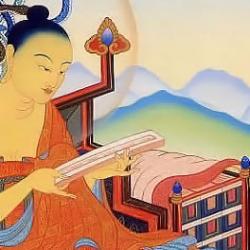- There is only one thing from the beginning, bright and mysterious. Unborn, undying, indescribable.
Many texts start with the easy stuff and get us into the deeper teachings slowly. Not this one. So Sahn is setting the tone for “Mirror of Zen” by throwing us straight into the deep end. He just walks up to us and says, “You know what? All things are one. And, man, this stuff is hard to understand.”
This is an expression of oneness. We are one with everything, that is our true nature. Nothing is left out. And it’s hard to understand. It’s good that he’s letting us know that it’s supposed to be “mysterious and indescribable” because if he didn’t tell us we might think we’re the only ones struggling with it.
This seems to reflect a Taoist influence. Buddhism was influenced by Taoism when it moved through China, before it got to Korea, so it’s no surprise it would have a little bit of that influence in So Sahn’s way of thinking. The Tao Te Ching says: “The Tao that can be spoken of is not the true Tao.” In the same way So Sahn is saying , “This is indescribable.” And then he goes on to try his best to describe it.
2. The appearance of all Buddhas and Patriarchs in this world is like waves coming out of the water.
The universe is like an ocean and all of us are like waves. There’s a reason he’s describing teachers as waves specifically, though. We also shouldn’t attach to and worship teachers so much. We’re all connected, so teachers aren’t separate from us. There’s a tendency in Buddhism sometimes to put teachers on a pedestal, to think of them as superior to us, even to worship them. So Sahn is warning us against this. Buddhas and Patriarchs are waves coming out of the water. They aren’t separate from us.
3. The Dharma has depths of meaning and people have different capacities. So, there are many ways in which the Dharma manifests.
This is an explanation for the vast number and range of Buddhist sects. Even in So Sahn’s time there were many different lineages and methods of practice. He’s not sad about that, he’s saying the Buddha created many lines of teaching for many different kinds of people. This is sometimes referred to as “upaya” or “skillful means”. I think skillful means is a really clunky term.
4. ‘Mind’, ‘Buddha’, ‘being’. Don’t be attached to labels like these. The real essence is just-like-this. Even one thought is a mistake.
We put labels on things and then pretend they’re important. We act like these labels have some ultimate reality and we forget that we made the labels in the first place. Hopefully our practice helps us disentangle from these tendencies. “Even one thought is a mistake” refers to our prejudgments and preconceptions. We already have thoughts and ideas about things before we even start examining them. I like to think about my kids in this regard. If I put food on their plate that they think looks weird, they have those preconceived ideas that they won’t like it. And who knows if they will or not. That’s just a really easy example. The point is that we’re all doing that all the time and that prevents us from seeing the world as it is.
5. The Meditation School comes from a wordless transmission of the Buddha from mind to mind. The Sutra tradition comes from spoken teachings of the Buddha. Zen is Buddha’s mind. Sutras are the Buddha’s words.
A special transmission outside the scriptures;
No dependence on words and letters;
Direct pointing to the mind of man;
Seeing into one’s nature and attaining Buddhahood.
Bodhidharma
The Ch’an School formed in China centuries after the Buddha’s death. Ch’an means meditation, so referring to it as the Meditation School is helpful to us. It’s said that in those days some people were practicing Buddhism in different ways. There were sects that had formed based on chanting and not meditating. There were sects that had formed based on just studying sutras all the time and, again, not meditating. The founders of the Meditation School saw this and started a lineage based on meditation practice above all else. Now the importance of meditation practice is emphasized in most branches of Buddhism, but in that time and place it was not. The founders of the Meditation School saw branches of Buddhism moving far away from the practice of the Buddha. So, when we study the sutras we are studying the words of the Buddha. When we practice we are doing the practice of the Buddha.
6. If you become attached to words, nothing will help you. If you see your true nature, everything will.
We have to practice. If we don’t practice, the words of the Buddha won’t help us. We can’t just talk about how great Buddhism is. Leave that to the philosophers. This is about practice, about relieving our suffering and helping others. I’ve found this to be important in my personal practice. I read the Diamond Sutra pretty early in my Buddhist studies and it was really hard for me to understand. After I had practiced for a while I read it again and it all meant a lot more. Practice brings insight.
7. Cutting off thought, forgetting everything, sit here with nothing to do. Spring comes and grass grows by itself.
Putting down all thought is a powerful thing. Just sitting, be here now. Nothing to do and nowhere to go. Reflect inwardly when thoughts arise. This is instruction for is what’s called “mozhao”, silent illumination. It can be traced back to Bodhidharma, who sat for nine years facing a wall in a cave. Ch’an Master Hongzhi referred to this practice as “cultivating the empty field”. One way to categorize this practice is as an objectless meditation. This is a definition in terms of what it is not. One just sits, not concentrating on any particular thing. Most traditional meditation practices involve focusing on something; a mantra, the breath, sounds, a mandala. And we can do some of these things as supplements to our practice. But the core is just sitting, just being here now. Silent Illumination is focused on a clear and non-judgmental attention to everything arising in our experience. Be here now.
8. Sutras transmit the Dharma of one mind. Zen transmits the Dharma of seeing our true nature.
Mind is described as the substance of a mirror. Our true nature is described as the reflective quality of the mirror. This is just a way of describing practice and sutra study as two sides of the same coin.
9. In sutras the Buddha draws distinctions between kinds of teachings and later explains Emptiness. In Zen all thought is stilled and Emptiness appears on it’s own.
This is another explanation for all the different branches of Buddhism. Even in So Sahn’s time, Buddhism was very diverse. And he’s expressing that the Zen tradition is great because it strikes right for the heart of the matter, Emptiness.
*all quotes taken from:
The Mirror of Zen: The Classic Guide to Buddhist Practice by Zen Master So Sahn Paperback – December 12, 2006













